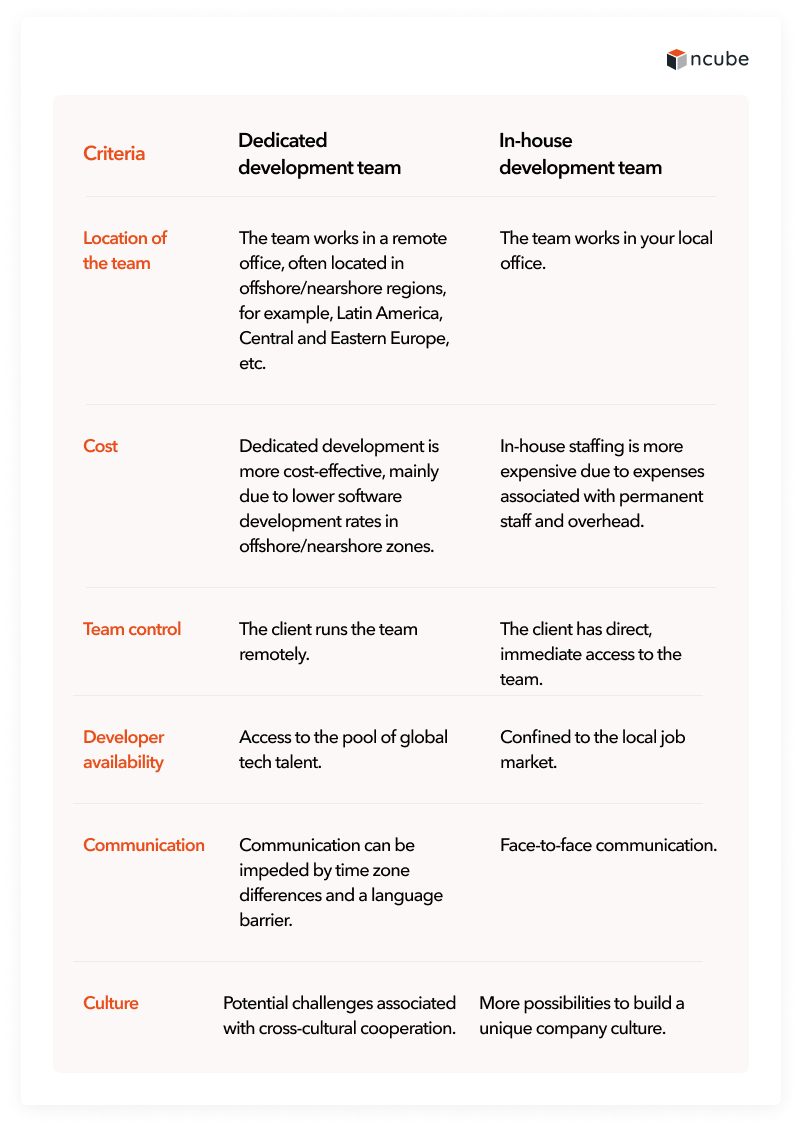
Dedicated Development Team: Why you Need it and How to Build one

What do Google, Slack, Alibaba, and WhatsApp have in common? They’ve all had external teams at the forefront of their success. Each of these brands faced unique challenges along the way, but dedicated development teams have proven to be a game-changer in helping them reach their goals.
Increased speed: Bringing a product to market quickly can be tough with only in-house resources to back you up. Slack tackled this by building an external dedicated software development team, enabling them to scale rapidly and gain thousands of new users.
Cost-efficiency: WhatsApp was working on a tight budget while aiming to launch a product that could make a splash. By delegating their software development to the vendors in Central & Eastern Europe, they discovered an excellent cost-to-quality ratio of local software engineers.
Access to expertise: Scaling quickly often means needing specialized skills that aren’t always readily available on the local market. That’s why many companies, including giants like Alibaba, have turned to Southeast Asia to find the experts they needed to keep pace with the growing platform.
Access to a global talent pool: It’s no secret that Google’s external workforce is much larger than its in-house team. This fact alone showcases the impact that dedicated development teams can have in handling large-scale projects and workloads.
The cases we highlighted here show how beneficial this model can be in many ways. But if you’re interested in finding examples that match your business, check out our success stories, where we showcase the diverse companies we’ve partnered with over the years. For instance, we’ve built dedicated software development teams for Life360, doTerra, Viber, and many others.
In this post, we’re diving into everything you need to know about dedicated development teams – from how the dedicated team engagement model operates and cost considerations to its strengths, weaknesses, and best locations for building your own team. Most importantly, we’ll help you decide if this model fits well with your business goals. Let’s dive in!
What should you choose for your project development – to build a dedicated development team vs hire a dedicated development team?
Building in-house development team lets you set up a development unit within your company walls but demands struggling with an overfished talent pool, soaring overhead costs, high employee salaries, and talent-retention perks.
On the other hand, when you hire a dedicated development team, you’ll access skilled software development experts in a talent-rich, cost-effective region. This model also lets you delegate overhead, payroll, and talent retention services to a competent provider so that you can stay focused on project management.

Dedicated software development: How it works
A dedicated development model suggests expanding your unit by adding dedicated software developers located in a region with lower development rates, such as Eastern Europe, Asia, and Latin America. Such a team is called “dedicated” because it’s solely dedicated to the client’s project, working full-time.
The client usually has direct access to each dedicated software developer.
The vendor of a dedicated engineering team takes care of recruitment, employee retention, office space, IT infrastructure, HR support, and employee perks. Below we dive deeper into the benefits of this model.

We at nCube ensure a dedicated software development approach lives up to its name. The virtual units we build are tightly interwoven into our client’s software projects. We always gather dedicated development teams from the ground up and tailor them to the client’s needs.
Feel free to check out the examples of dedicated development teams we built for our clients here.
Advantages of a dedicated development team
It’s more affordable than in-house staffing
Accelerance reports that the hourly rates across software development roles increased by 23% in 2022. This highlights the financial benefits of dedicated development.
Hiring a full-time software developer in the United States or Western Europe costs between $125,000-$200,000 per year, without recruitment, onboarding, administration, and employee benefits packages.
With a dedicated development team, you can avoid added expenses that come with an in-house team, as they are taken care of by the vendor. Moreover, you can source tech talent in such cost-effective regions, such as Central & Eastern Europe or Latin America.
It resolves team scaling problems
The US Bureau of Labor Statistics reports that the demand for software engineers is expected to grow by a staggering 25% until 2032, which is 8 times faster than the average growth (3%).
It only means one thing – competing for tech talent is going to be more and more difficult. Fortunately, there’s always an option to scale quickly with dedicated software developers whenever your project requires extra hands.
A dedicated team model is best when you need to bring the project up to speed to meet the timeline requirements.
You’ll get a jump on time-to-market
Speed is another benefit associated with a dedicated development team. In our experience, you can build one within 2-6 weeks, depending on the number of team members.
You’ll have access to developers with sought-after expertise
According to a recent report by Robert Half, 90% of tech managers say that finding top talent remains a challenge.
This brings us to yet another reason to work with a dedicated team – the variety of specialists in the global talent pool. For example, in Eastern Europe, you can find a dedicated software developer with expertise in major verticals, such as healthcare, banking, fintech, and more.
A dedicated team based in a skilled tech hub like this can bring the expertise you lack to the table.
Your office will be up and running around the clock
Running a remote team comes with its challenges, but this work model also provides a lot of coverage, given that two teams working 8 hours equals 16 hours a day dedicated to your project.
This way, thanks to dedicated development, you can increase your development capacity ×2.
It frees resources to concentrate on your core business
A dedicated software team gives you much more time to focus on your core business and vital processes.
It’s proven that by engaging dedicated teams, numerous companies have managed to bring software solutions that had a transformative power on their business model.
Disadvantages of a dedicated development team
Time zone and communication barriers
The biggest challenges that come with a dedicated development team model is working across time zones. Collaborating with a tech unit located far away means your in-house and remote teams have little overlap for communication at the same time.
To overcome this, you need to schedule your meetings around the common time windows. While such communication can be effective, it falls short of face-to-face interaction related to the in-house staff.
Thus, a dedicated development team located in a nearshore zone, where time zone differences are negligible, can offer a solution to overcome this obstacle.
Management is more intricate
Running a dedicated development team is more complicated than running an in-house unit. You’ll need to account for time zone differences, culture differences, and work styles in your management approach.
One thing you can feel sure about with dedicated development is that team members will be fully dedicated to your project, which is the essence of this model.
Selecting the right vendor, and conducting regular meetings and surveys, just as you do with your in-house developers, will simplify your management.
It’s not the most flexible model
Although a dedicated development team offers more agility than in-house staffing, it’s still less flexible than Staff Augmentation (SA) in terms of adaptability.
With SA, you can add team members to your project on an as-needed basis – as opposed to the rigid formation of a dedicated development team. Once a dedicated team is formed, integrating new skills can be problematic, as it may impact the entire project.
A huge stumbling stone with this model can be maintaining communication and team control in a remote setting. The key is in selecting the right tools and setting the right processes. However, it would be better for a manager of a dedicated development team to have relevant experience in managing remote teams or research and development centers.
Let’s recap this part. When choosing between an in-house and a dedicated team, many companies lean towards the latter, mainly due to the high costs of local developers.
Build your dedicated team of skilled developers
A dedicated development team vs an in-house team: Key differences
“Should I build a dedicated team or a traditional in-house team?” Many tech leaders inevitably come across this question when the need for team scaling arises.
Let’s compare the concept of a dedicated development team vs. in-house development across various criteria.

What is the structure of a dedicated team?
The roles within a dedicated development team resemble those within an in-house unit, although you may want to backfill some of them with in-house staff. Let’s explore key roles in dedicated development.
Project Manager (PM)
PM is an expert who drives the software development process and supports your dedicated development team throughout the project. They will ensure your project stays on track and report to you on its progress.
Business analyst (BA)
The role of a BA is to align the software development process with your business goals. Oftentimes, BA serves as a bridge between stakeholders and a dedicated development team. The key task of a BA is to ensure your business needs are translated into tech specifications.
Software Architect
A software architect is the mastermind behind your project. They design the overall structure and guide your dedicated development team on how to build and integrate different components of a software product.
UX/UI designers
User Interface (UI) and User Experience (UX) experts will craft the design and usability of your software product. Their job is to create a user-friendly, intuitive, and attractive design for users.
Software Engineers
A development team, consisting of front-end and back-end experts, is the backbone of every project. These roles are the most costly on your dedicated development team.
Quality Assurance (QA)
QA experts are on guard for your software quality. They thoroughly check if your software meets the standards of usability, security, and performance before it goes live.
DevOps
A key part of a dedicated team structure, DevOps engineers focus on automating and refining processes aiming to enhance the speed, efficiency, and quality at every stage of software development.

Dedicated software development: Cost
Now that we’ve analyzed the key roles, let’s dive into the cost aspect. Below, we compared the rates of various tech roles in North America with rates for the equivalent roles in nearshore/nearshore zones.
We believe this information may be useful for you to make an informed decision when selecting the location to hire dedicated developers.
You can see that opting for LATAM or CEE for dedicated software development is more cost-effective than in-house staffing in North America.

How to build your own dedicated development team: Step-by-step guide
When building a dedicated software team, you want to source dedicated software developers with the right skills to bring your project to success.
There are two major parties involved in this process: Customer and Provider. The responsibilities in outsourcing software development are typically divided in the following way:

Now that we’ve outlined the responsibilities of each party, the next question would be where to start?
Step 1. Define your requirements
Before contacting the vendor, you should decide on a team size, roles tech stack and prioritize features so that a vendor can build a dedicated development team based on your needs. Giving information about your company will help find developers who would be a good fit in terms of company culture.
Step 2. Interview dedicated software developers
Typically, the hiring process includes several rounds of interviews. The candidates are initially verified by the vendor’s team, which involves technical and HR interviews. Then, the candidates who’ve made the cut are forwarded to the client for client interviews.
During the hiring process, you may want to take the provider for a spin. Take notice of their company culture, communication style, and ability to meet your requirements. That will allow making an informed decision.
With nCube, there’s no need to pay upfront until you are ready to hire a dedicated software developer. We also are open to signing a non-disclosure agreement before we start our cooperation.
Step 3. Launch your team
If you have chosen the team members carefully, chances are high that your dedicated development team will be a success. At this point, a lot depends on your involvement in the project.
Set up the processes and communicate with team members regularly. If you choose nCube, you’ll be working with developers from CEE or LATAM who have high technical proficiency, a problem-solving mindset, and strong communication skills.
Build your dedicated team of skilled developers
Dedicated software development team: Where to build it?
Let’s take a look at the countries that are the most comfortable for launching your dedicated software development team.

Eastern Europe
When it comes to the best countries to launch your dedicated development team, many Eastern European countries (Ukraine, Poland, Romania, etc) are globally recognized as hotspots for this activity.
In Eastern Europe, developers have vast experience working on global software development projects and excel at diverse technologies. Particularly, Ukrainian and Polish developers are well-versed in JavaScript, Java, C#, Python, PHP, Swift, and C++ as well as in-demand fields, such as Data Science, IoT, Blockchain, and AI/ML.
When you go for dedicated team development in this region, you can rely on a repository of nearly 1 million expert IT specialists. Dedicated team development in this region is also a lucrative option thanks to a convenient time zone, no-barrier communication, and minimal cultural discrepancies.
So, when sourcing dedicated software developers from Eastern Europe, you can optimize your budget without any trade-offs.
LATAM
LATAM is currently a growing tech hub, where such countries as Mexico, Argentina, and Brazil stand out as the most popular destination for dedicated development. LATAM is also a preferred region for US-based companies seeking nearshore opportunities.
Akin to Eastern Europe, LATAM offers affordable software development rates compared to North America. LATAM nations are close to the US when it comes to the time zone, so many businesses prefer to launch dedicated software development teams and R&D teams in this region.
Besides that, providers in LATAM are laser-focused on North American projects, which allows them to have a deep understanding of their inner workings, requirements, standards, and goals.
We at nCube focus on both of these regions and will help you set up your own dedicated development team in the destination of your choice.
A dedicated development team: Is it the right approach for your business?
To summarize our post, we’ve gathered a few scenarios where adopting a dedicated development model may be a suitable choice for your business.
- You want to shift the focus of your core team toward strategic initiatives rather than stick to a day-to-day development routine.
- Your organization lacks software development expertise;
- You need to rapidly scale up your development capacity because of an increasing workload;
- You prioritize sustainable Agile development teams for projects with long development cycles;
- You want to accelerate time-to-market by building a skilled development team fast;
- You want to add skilled technologists without delegating team control and SDLC to the vendor;
- You lack specific skills for a particular stage of SDLC, for instance, Quality Assurance.
Why choose nCube’s dedicated development team services
nCube is a professional provider of dedicated development team services with over 16 years of experience.
We have extensive experience in setting up external teams in the Eastern European and Latin American markets, providing services from custom software development team formation and talent retention to overhead, legal, accounting, and HR support. We’ll help you find the right talent for your project, matching the required rate and skill set. With us, you can:
Hire dedicated teams fast
It typically takes us 2-6 weeks to get a team ready to go. We initiate the candidate search process after our kick-off call and start searching for the matching profiles. The CVs of fitting candidates will reach your mailbox within 24 hours after our call.
An evergreen tech talent pool
If your project relies on in-demand skills – AI, machine learning, cybersecurity, cloud computing, data science etc. – building a strong dedicated software team requires access to a broad talent repository. nCube has a pipeline of 125,000 skilled software engineers so we can help you add the talent you need, accelerating development and preventing delays caused by talent shortages.
Full control over the team
With our dedicated development company, you’ll be in the driver’s seat for all team decisions – from hiring to project management. It means that you can select the processes and methodologies (be it Waterfall, nearshore Agile development, or any other model) and the team will follow it.
Moderate software developer rates
Our model lets you achieve cost-efficiency due to lower software development rates compared to North American and European markets. Additionally, office space, team retention, payroll, and employee perks are on us.
Zero-risk testing for new projects
Many software development initiatives come with inherent risks. When there’s no 100% guarantee that your project will work, hiring a permanent squad or overloading your current software developers team with additional tasks can be risky. Instead, dedicated developers will let you test your project’s potential, without locking yourself in long-term commitments with in-house staff.
Conclusion
At the end of the day, there is no universal recipe for developing software. In some scenarios, it’s best to go with an in-house software development team. In others, a dedicated team can be the right solution, especially when you want to scale your internal team fast and prune the extra costs associated with an in-house team.
Together with a dedicated development team from nCube, you can build long-term relations with the best tech talent in Eastern Europe and LATAM. Learn more about how nCube’s dedicated team model works or contact our experts for consultation.
FAQ
Frequently asked questions about a dedicated software development team
What is a dedicated development team?
A dedicated development team is a software development unit of skilled experts aligned to work together. This team is solely dedicated to the client’s project, working full-time, from an office set by a provider in a nearshore location like Eastern Europe or Latin America.
Why hire a dedicated development team?
There are several reasons why companies hire a dedicated development team: access to a greater pool of talent, faster team scaling and staffing, access to niche expertise (AI/ML, IoT, Cloud, Data, etc.), increased development capacity, and lower rates.
How to build a dedicated development team?
To build a dedicated development team, you can take 3 simple steps: Start with defining your requirements, interview candidates recommended by a provider, and launch your team.
What are the benefits of hiring a dedicated development team?
Compared to an in-house development team, hiring a dedicated development team assumes much greater access to tech talent, zero overhead, and lower cost of software developers. You can focus on your project while the provider focuses on your team and its comfort.
Recommended articles


